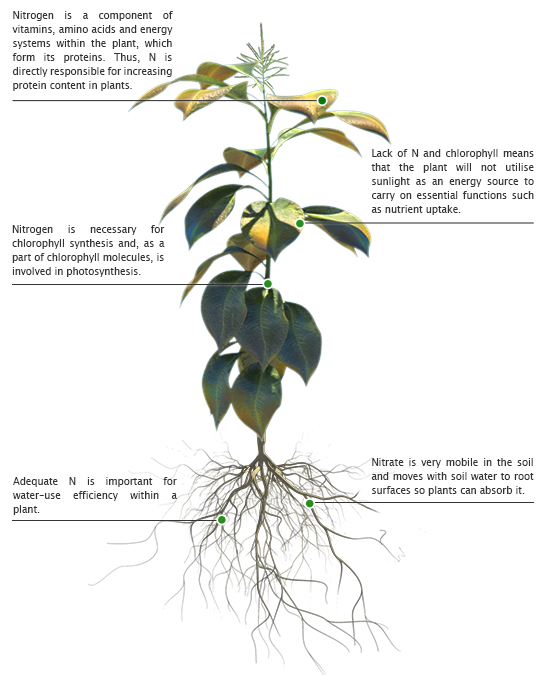 The Role of Nitrogen (N)
The Role of Nitrogen (N)
Nitrogen (N) is essential for plant growth and is part of every living cell. It plays many roles in plants and is necessary for chlorophyll synthesis. Plants take up most of their N as the ammonium (NH4+) or nitrate (No3-) ion. Some direct absorption of urea can occur through the leaves, and small amounts of N are obtained from materials such as water-soluble amino acids.
Nitrogen surrounds all plants in our atmosphere. In fact, every acre of the Earth’s surface is covered by thousands of pounds of this essential nutrient, but because atmospheric gaseous N presents itself as almost inert nitrogen (N2) molecules, this N isn’t directly available to the plants that need it to grow, develop and reproduce. Despite its identity as one of the most abundant elements on Earth, deficient N is probably the most common nutritional problem affecting plants worldwide.
Healthy plants often contain 3 to 4 percent N in their above-ground tissues. These are much higher concentrations than those of any other nutrient except carbon, hydrogen, and oxygen – nutrients not of soil fertility management concern in most situations. Nitrogen is an important component of many important structural, genetic, and metabolic compounds in plant cells. It’s a major element in chlorophyll, the compound by which plants use sunlight energy to produce sugars from water and carbon dioxide, or, in other words, photosynthesis.
Nitrogen is also a major component of amino acids, the building blocks of proteins. Some proteins act as structural units in plant cells, while others act as enzymes, making possible many of the biochemical reactions on which life is based. Nitrogen appears in energy-transfer compounds, such as ATP (adenosine triphosphate), which allows cells to conserve and use the energy released in metabolism. Finally, N is a significant component of nucleic acids such as DNA, the genetic material that allows cells (and eventually whole plants) to grow and reproduce. With the exception of photosynthesis, N plays the same role in animals, too. Without N, there would be no life as we know it.
Adequate N produces a dark green color in the leaves, caused by a high concentration of chlorophyll. Nitrogen deficiency results in chlorosis (a yellowing) of the leaves because of the declining chlorophyll. This yellowing starts first on the oldest leaves, then develops on younger ones as the deficiency becomes more severe. Slow growth and stunted plants are also indicators of N deficiency. Small grains and other grass-type plants tiller less when N is in short supply.
Source: Soil Fertility Manual (2006) by the International Plant Nutrition Institute (IPNI) and the Foundation for Agronomic Research (FAR).